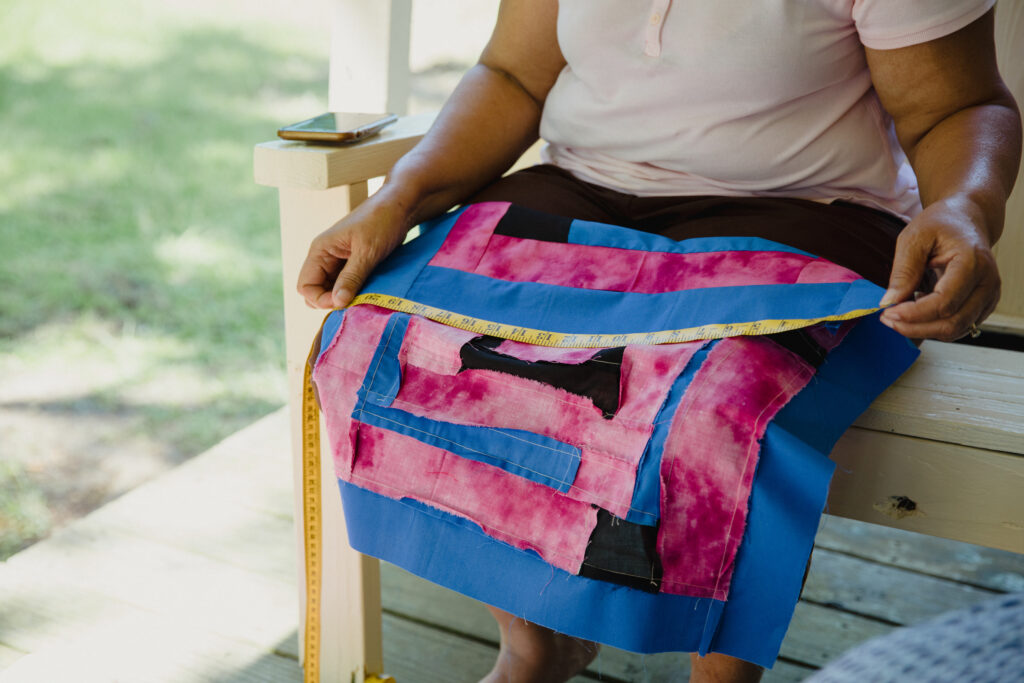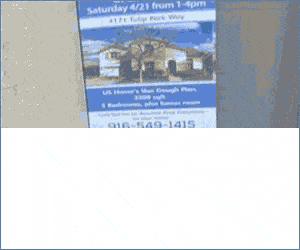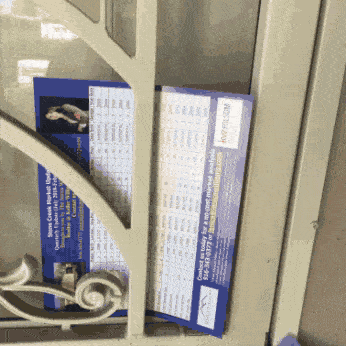[ad_1]
Gee’s Bend is known as living history due to the region’s generations of Black female quilters. The quilts, initially created for comfort and warmth, have become a symbol of Black survival and civil rights activism. But now the Alabama-based quilters are stepping out of the history books and into the mainstream fashion and home-good industries with the help of creative and economic nonprofit Nest.
Nest describes as a nonprofit 501(c)(3) “supporting the responsible growth and creative engagement of the artisan & maker economy to build a world of greater gender equity and economic inclusion.” The nonprofit’s programs aim to give the country’s artisans sustainable livelihoods by “bringing radical transparency and opportunity to the informal handworker economy.”

Rebecca van Bergen, Nest’s founder and executive director, told Blavity that Nest and the Gee’s Bend quilters began their relationship around 2016. She said that the team traveled to Gee’s Bend and stayed in touch with the quilters for years, “learning about the quilters and their strategies and goals.”
A nonprofit in the area, Souls Grown Deep, reintroduced the team to the quilters later, leading Nest to formally start collaboration talks.
“With communities like the Bend, we take everything really slowly,” van Bergen said. “It’s really important to us that we build trust, that we’re listening, that all of the programs that we think of or conceive are built in partnership with the community [and are] community-led.”
A cornerstone of Nest’s program with the quilters was licensing.
“[With] historic quilts that were ending up in museums or art galleries, there were licensing fees [or] royalty fees that were associated with that,” van Bergen said. “There was a lot of strategy around placing historic and antique quilts with other museums or galleries. But a lot of the quilters are still actively quilting. And so there was not a lot happening around helping build greater markets for the production of new quilts. And so new quilts, or [other things made by the quilters] — wall hangings and potholders and a whole host of other things with their skills — that was [what we] really kind of settled on as what our main thrust would be.”
“There wasn’t so much interest in the Bend. If you were interested in buying a quilt, basically your only option was to either go to an art gallery that might happen to have one … or go to the Bend and hope you meet a quilter on the street and ask her if anything was for sale,” she continued. “There wasn’t like a direct e-commerce platform or sales strategy for getting new quilts into the hands of the thousands of people that were followers and remain followers. And so we ended up deciding collectively that we would approach Etsy as a partner so that the quilters could build individual Etsy shops.”
Van Bergen explained that through Etsy, each quilter is their own individual business. She also called the company “an amazing partner,” adding that it “invested philanthropically in the community,” provided educational e-commerce workshops, donated professional photography and, even more importantly, waived all of the quilters’ fees.
“We had this incredible launch with Etsy that really, for the first time, brought many of the quilters online into e-commerce, and they sold out,” van Bergen said.
After the success with Etsy, Nest then linked the quilters to other licensing agreements with fashion retailers, including Chloe, Greg Lauren, Marfa Stance, and more. These deals are not one-offs either; they are multiyear partnerships, which means deeper mainstream investment into the Bend. Van Bergen estimates that the direct revenue reaching the quilters equates to around 1.2 million dollars.
“[It] is just amazing to see that kind of interest and to see that translate to real economic value for the quilting community in the Bend,” she said.
Turning the quilters’ talents into sustainable businesses has not only helped the quilters economically, but has also helped preserve quilting history for future generations.

“I think one of the amazing things we’ve seen is that for so long, a lot of the younger generation didn’t necessarily see quilting as something that would hallow them to have economic prosperity, so they weren’t pursuing it. And so there are some amazing stories from the quilters that [their] adult children are now picking up the craft and are continuing the craft,” van Bergen said.
“There are now a lot of sons who are quilting, which was predominately female. To see men seeing the value of the quilts and wanting to preserve it and participate is super exciting, too,” she added. “The kind of cultural connectivity and continuity that’s happening as a result of the kind of drive and interest and economic outcomes is super awesome.”
Nest’s work in Gee’s Bend is part of the company’s Makers United initiative, which focuses on putting interest, money, and attention back into America’s maker economy. It also aims to better diversity, inclusion and equity within the makers community.
“A lot of major companies were making investments in local makers … from Portland, Oregon, and Brooklyn and San Francisco, but not the full rich history of American craft, and definitely not more disadvantaged communities that might face disproportionate access issues to financing and market building and marketing and all the things,” van Bergen said. “Makers United is [there to] help support, identify and invest in diverse makers.”
Birmingham, Alabama, was the first city Makers United invested in, and subsequent cities include Chicago, Detroit, St. Louis, Austin, San Antonio and Houston. The initiative is also helping makers in the South Carolina-Florida corridor, Eastern Kentucky and the Appalachian region as well as Indigenous makers and makers who are refugees and immigrants.
“It’s kind of both like an urban program, but then also really wanting to invest in some of our nation’s most historic crafts, especially those that predated us and our forced arrival onto this land,” she said.
Claudia Pettway Charley is one of the quilters of Gee’s Bend, and she also serves as Nest’s community manager in Birmingham. Pettway Charley said she’s a fourth-generation quilter and is passing on the craft to her daughter.
“Quilting has always been a part of my family’s legacy,” Pettway Charley told Blavity in an interview. “I grew up with quilts. Of course, that was the only cover that we had in our home. And basically, I would pretty much watch the ladies come together at my house and they would quilt together, they would sing, and then they would pretty much talk about their lives. So I think quilting was therapeutic for the women in Gee’s Bend, especially my grandmother, who had five kids, and worked a lot.”
She explained how the quilters were also women balancing the responsibilities of Black life.
“My family has always been a hardworking family to the point where they would get up early in the morning and they would go to the fields to plant crops and things like that. So that took up most of the day. And even after that, they would still have to come home and do their basic domestic duties,” Pettway Charley said. “I’ve always been surrounded by hardworking women, women that survive, so I look at my family as a group of people that actually survived through those hard times.”
The Gee’s Bend quilts are seen as art pieces now, but their original use was exactly what other quilts are used for — to protect, comfort and provide warmth. They also had a cyclical life — the more they were used, the more they returned to their original state, only to be quilted again.
“Quilting is really everything. It means a lot because again, we needed that cover for the winter months — we didn’t have heat in the house, just a fireplace,” Pettway Charley explained. “So this was used for many things, like robes. Sometimes, they get all torn up [and] were used for mops. They [were used as] saddlebacks … [there were] so many different meanings for those quilts. So they would kind of go through stage one through stage five, and by that time, it’s actually pretty much back to thread again.”
Pettway Charley said that the partnership between the quilters and Nest “has been great,” adding that the company was “willing to work with the [quilters] and willing to listen to what we have to say.”
“It’s a great relationship because you’re talking women to women and they are here at all times. I mean, they’re very supportive,” she continued. “They provide workshops and education to help us with whatever we’re needing. We like that idea because a lot of things we don’t know how to do; they help introduce us to other organizations and companies that want to work with the Gee’s Bend quilters. And we trust that when they bring people to us that they have to be good people who are going to do what they say they’re going to do.”
“We’re able to be compensated fairly, unlike other organizations that have come into Gee’s Bend who left a bad taste in our mouths. So Nest is very refreshing for the community. It’s very refreshing for me to see they’re easy to work with, and it’s a really great relationship,” she said. “They’ve been with us for about four years or more and we’ve done a lot of great things together. And we’re going to continue to do great things together.”
One of those big opportunities was the recent Target x Gee’s Bend collaboration during Black History Month this February. The quilters created home goods including throws blankets, throw pillows, quilted journals, handbags, pouches and jackets. Pettway Charley said she was “beyond impressed” and “beyond excited” about the collab.
“We had no idea what that particular licensing deal was going to bring, the type of attention that it brought for Nest and Gee’s Bend. I mean, it was the best deal that I’ve ever participated in, that a lot of the women have ever participated in,” Pettway Charley said. “I think the fact that we both really were like, ‘What’s going to happen?’ We weren’t prepared. … And it was really a major success to see our designs [and the] merchandise that we chose. The great thing is that Target was very open to let us make pretty much all the decisions of what we wanted to have, and that was really, really good.”
“I think one of the main things is that the merchandise was affordable and the fact that it was Gee’s Bend, and the fact that we were celebrating Black history, which is our history [with a] variety of products and price points that were really, really great for everyone. … The coolest of all of [the collaborations] was Target,” she continued. “So we were very pleased with the outcome of that particular deal. All of us are just really pleased and we are very blessed to have been able to work with a company like that.”
Other programs Nest is working on includes the Makers Future Fund, which specifically addresses financing hurdles makers have when turning their craft into a sustainable business. Van Bergen discussed how the fund will address long-standing economic discrimination against makers, especially makers of color.
“There are lots of statistics about how few banks lend to micro or small businesses, period, and then add in lower income, racial diversity, all the other factors, and there’s just no financing available for people,” van Bergen said, adding that Nest is “super excited” about the fund’s upcoming launch.
These initiatives not only safeguard the cultural integrity of makers’ work while creating a profitable business, but they also safeguard the makers’ livelihoods in the wake of ecological and social changes.
“The income that [the businesses are] providing is resilience income,” van Bergen said. “It’s how they got through COVID. It’s how they’re going to get through climate change. It’s the money that allows their kids to have access to education and other things. [We’re] really building up a stronger narrative and we hope we can play a part in that and how important side hustle income is to so many people. In the last few years, the changes that have been thrown at us economically, politically, health-wise, all of it, I think [resilience income] has never been more important.”
“I think craft gets a bad name,” she continued, adding how crafters are often stereotyped as creating kitschy work. She emphasized how the quilters and other crafters in their programs are true artists.
“[We’re] really trying to rewrite a narrative around the value of and beauty of what craft actually is,” she said.
[ad_2]








